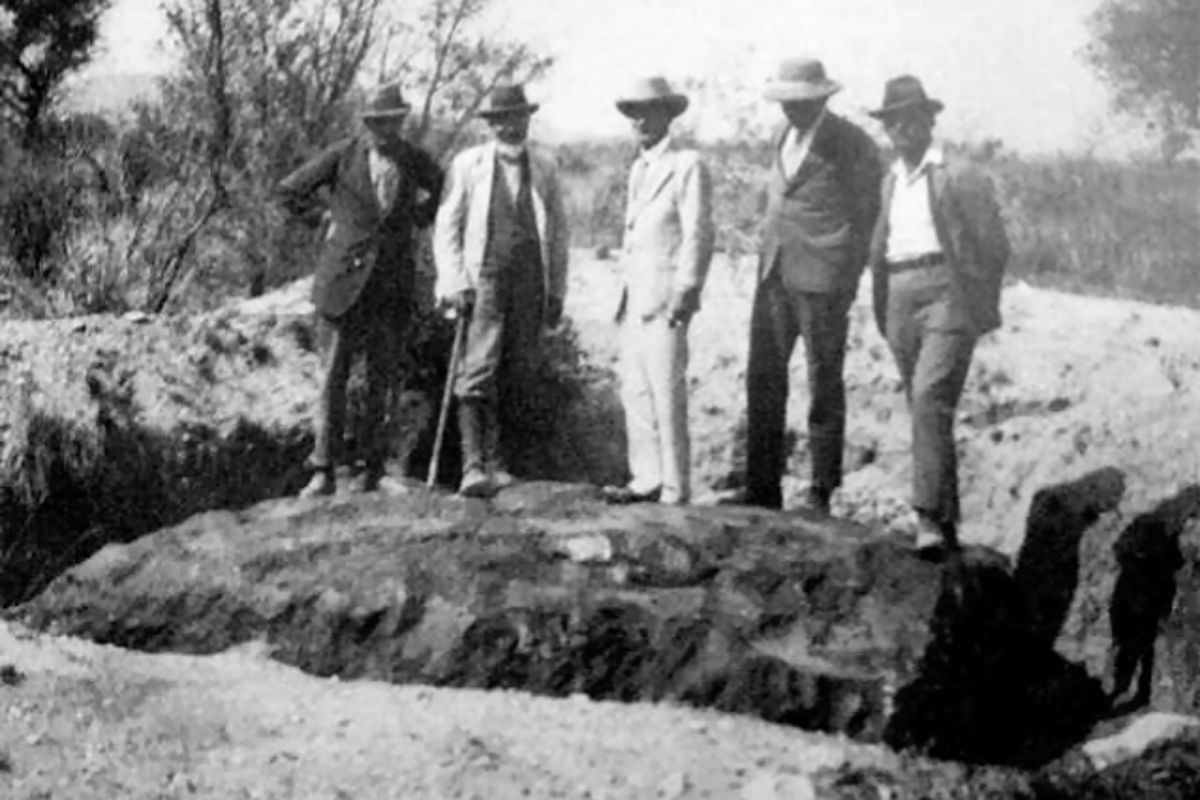- Date with the sky Spring 2020: 10 things you should know about the season that begins
- Chronicles of the cosmos. Vibrant dark matter controversy
The world's most extraordinary meteorite was discovered in northern Namibia in 1920. Weighing in excess of 61 tons, it is the largest natural piece of iron found on our planet. Surprisingly, there is no indication of a crater around it.
Fallen from the sky
The largest one-piece meteorite was discovered a century ago on the Hoba West farm in northern Namibia. Known as the 'Hoba meteorite', this impressive block of iron (it really is an iron-nickel alloy) has a peculiar rectangular shape of 3 x 3 x 1 meters and a weight that exceeds 61,000 kilos. It is estimated that it was formed about 300 million years ago and that it fell on Earth less than 80,000 years ago .
The Hoba was discovered lying horizontally on level ground with its upper face level with the ground. The site is located about 20 kilometers west of Grootfontein and 65 kilometers southwest of the mining town of Tsumeb; can be located with Google Maps at this link.
Over the 100 years since its discovery, numerous pieces of the phenomenal piece of iron were detached or cut by scholars, vandals, and vandals. Today 18 pieces of the Hoba are known in different collections distributed around the world. However, it is estimated that, in total, only about 25 kilos of the original meteorite have been shed .
Fortunately, the meteorite, together with the area of land of about 25 meters in diameter that surrounds it, was declared a national monument in 1955 by the government of Namibia (known at the time as Southwest Africa), which has allowed it to be preserved, such and as it was then, to this day.
In the 1920s, a ditch had already been dug around the meteorite. In the 1980s, the farm owner donated it to the Namibian government, which then built a kind of large amphitheater around it, and incorporated explanatory elements. Today it is still a major tourist attraction.
Ataxite
Although complicated classification schemes are currently in place, meteorites have traditionally been categorized into three broad groups: rocky (aerolites), metallic (siderite), and rocky-metallic (lithosiderites). Obviously, Hoba's belongs to the class of metallic meteorites. Due to their composition and high density, these meteorites undergo less ablation, due to atmospheric friction, than those of the other classes and, therefore, tend to be larger.
Metallic meteorites are classified, in turn, according to their composition. The Hoba meteorite belongs to the group of ataxites , which are characterized by their high nickel content (16%), they also have traces of cobalt and a very low abundance of volatile elements.
Where's the crater?
In addition to its enormous size, the first thing that caught the attention of the Hoba is the absence of a crater around it. There is no clear explanation for this, although several hypotheses can be ventured.
First of all, let's remember the very regular shape of the meteorite, with such smooth rectangular faces. It is not impossible that this peculiar flat shape allowed the meteorite to be effectively braked in the atmosphere . And even if it had dropped low, bounce slightly first on the surface of the atmosphere and then on the ground, similar to how a stone does when we throw it on the surface of the water in the popular frog game.
But it is also possible that the metal block had fallen on a mass of ice and that the hole formed had disappeared when the ice melted.
Other super meteorites
Be that as it may, the Hoba meteorite is a fascinating and absolutely exceptional object. The weights of the three meteorites that follow do not reach half the weight of the first.
Two of these meteorites, which are around 30 tons, and which are especially interesting are the Gancedo -which was discovered not long ago: in September 2016- and El Chaco. Both were part of a phenomenal meteor shower that took place on a somewhat surreal site known as Campo del Cielo, in Argentina. It is an elongated strip of land, about 3x18 kilometers, in which 26 craters and numerous meteorites have already been found that add up to a total mass of about 100 tons. Quite possibly, they are fragments of the same original body that could have been about four meters in diameter and that broke when falling on Earth.
Iron meteorites make up 5% of all known meteorites. They are believed to come from metallic asteroids (called M-type), which, in turn, are pieces of the metallic core of other larger asteroids that were fragmented by large impacts in the early stages of evolution of the solar system. The largest metallic asteroid, Psyque, is about 200 kilometers in size and is located in the large asteroid belt between the orbits of Mars and Jupiter. This asteroid will be closely studied by a spacecraft -also called Psyque- that will be launched by NASA around 2022 to fly over the asteroid in 2026.
The study of the composition and age of different types of meteorites is of great help in reconstructing the physical and chemical processes that took place during the formation and early evolution of the solar system.
Rafael Bachiller is director of the National Astronomical Observatory (National Geographic Institute) and academic of the Royal Academy of Doctors of Spain.
In accordance with the criteria of The Trust Project
Know more- science
- Science and health
Geology Torrential rains contributed to the 2018 Great Eruption of Hawaii's Kilauea Volcano
Covid-19The most effective formula to lower the curve according to chaos theory: strict social distancing and massive tests
Earth Day Europe heats up faster than the rest of the planet

